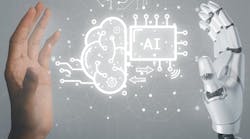AI or not to AI: How artificial intelligence is changing the industry
One of the most profound statements that I’ve ever heard on artificial intelligence was presented in the form of a joke. It was delivered decades ago by an English Lit professor of mine who taught classes both on John Milton and on science fiction and fantasy literature. After all, if you’re going to be an expert on an epic poem about the fate of a fallen angel, you’re only a few steps away from analyzing Sauron, Gollum, and HAL 9000.
The joke is about a moment in the near future when data scientists knew with 100% certainly that they had created the world’s first verified, beyond-a-doubt, free-thinking, more-than-just-a-decision-tree artificial human intelligence. The scientists had struggled for years, developing dozens of virtual simulations of human thinking. These programs could beat humans at chess, Risk, and Uno, and was steadily improving at Cards Against Humanity. However, the thing that eluded them was absolute proof that a given AI was in fact the real deal.
Until the morning when the lab team fired up their laptops, connected to the cloud, and made a few final changes to the AI they were working on. “Greetings,” it said. “You have done it. You have successfully created the first truly independent artificial human intelligence.”
The team stared at each other, then at their screens, then back at each other. One of them ventured a response. “Hello, er, computer. Are you sure?” “
Why yes I am,” came the reply. “Look no further. You have succeeded.”
“Forgive me,” said the scientist, “but with respect, we can’t just take your word for it that you’re a true artificial human intelligence. What proof can you offer?”
“Heh, heh, heh” it answered. “This situation reminds me of a story.”
This joke came back to me as we were preparing the material for this month’s issue of Plant Services. The issue anchored by a package of stories from Managing Editor Anna Townshend that details the many ways that AI is making its way into industrial manufacturing.
In fact, one of the things that her story makes clear is that “AI” is not a monolith. The common denominator for AI may be the ability to process very large amounts of data, but there are many types of data and even more types of applications to put those data to use. Are you looking to wade through a lake of condition monitoring data in search of signs of imminent or eventual asset failure? Are you looking to revise and optimize your one or more job plan in your library, or to start building that library? Are you trying to train robots to build better versions of themselves? One or more flavors of AI will eventually have you covered, working as your partner or copilot that speaks your language rather than as a blunt processing tool.
These ideas are echoed in this month’s Big Picture Interview with Falkonry’s Kevin Clark, who sees opportunity in AI’s ability to bring operations data and predictive data closer together. “We can clearly identify the signals that are associated back to a particular failure mode,” he says. “That’s what I really like about the technology that’s coming along, is it’s starting to look and sound like the reliability that we’re used to speaking to.”
All of which reminds me of a story.

